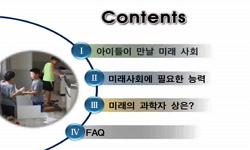The purposes of this study were to investigate the correlation between the cognitive level and the probabilistic thinking level and to analyze the effects of the probability activities in Thinking Science (TS) program on the development of probabilist...
http://chineseinput.net/에서 pinyin(병음)방식으로 중국어를 변환할 수 있습니다.
변환된 중국어를 복사하여 사용하시면 됩니다.
- 中文 을 입력하시려면 zhongwen을 입력하시고 space를누르시면됩니다.
- 北京 을 입력하시려면 beijing을 입력하시고 space를 누르시면 됩니다.


Thinking Science 프로그램의 확률 활동이 중학생의 확률적 사고 형성에 미치는 효과 = The Effects of the Probability Activities in Thinking Science Program on the Development of the Probabilistic Thinking of Middle School Students
한글로보기https://www.riss.kr/link?id=A101030569
-
저자
신경인 ; 이상권 ; 신애경 ; 최병순 ; Kyung-In Shin ; Sang-Kwon Lee ; Ae-Kyung Shin ; Byung-Soon Choi
- 발행기관
- 학술지명
- 권호사항
-
발행연도
2003
-
작성언어
Korean
- 주제어
-
등재정보
SCOPUS,KCI등재,ESCI
-
자료형태
학술저널
-
수록면
165-174(10쪽)
- DOI식별코드
- 제공처
-
0
상세조회 -
0
다운로드
부가정보
다국어 초록 (Multilingual Abstract)
The purposes of this study were to investigate the correlation between the cognitive level and the probabilistic thinking level and to analyze the effects of the probability activities in Thinking Science (TS) program on the development of probabilistic thinking. The 219 7th grade students were sampled in the middle school and were divided into an experimental group and a control group. The probability activities in TS program were implemented to the experimental group, while only normal curriculum was conducted in the control group. The results of this study showed that most of 7th grade students were in the concrete operational stage and used both subjective and quantitative strategy simultaneously in probability problem solving. It was also found that the higher the cognitive level of the students, the higher the probabilistic thinking level of them. The sample space and the probability of an event in the constructs of probability were first developed as compared to the probability comparisons and the conditional probability. The probability activities encouraged the students to use quantitative strategy in probability problem solving and to recognize probability of an event. Especially, the effectiveness was relatively higher for the students in the mid concrete operational stage than those in any other stage.
동일학술지(권/호) 다른 논문
-
새로운 다핵성 시프염기들의 합성과 Cu(II)착물에 의한 아스코르브산의 산화반응
- 대한화학회
- 김선덕
- 2003
- SCOPUS,KCI등재,ESCI
-
물리변화와 화학변화에 대한 중등학교 과학 교과서의 개념 분석
- 대한화학회
- 백성혜
- 2003
- SCOPUS,KCI등재,ESCI
-
trans-[CrX2([15]aneN4)]+(X=F,CI)의 전자분광학과 리간드장 해석
- 대한화학회
- 최종하
- 2003
- SCOPUS,KCI등재,ESCI
-
- Korean Chemical Society
- 최기영
- 2003
- SCOPUS,KCI등재,ESCI




 DBpia
DBpia


